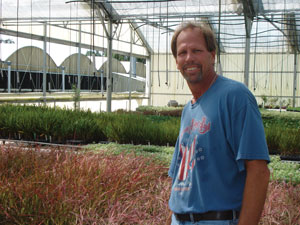6/15/2010
Preserving the Future
Barbara Mulhern

Mike Rinck is realistic about how difficult it would be for a small grower to get into the tissue culture liner business today.
“Our commercial lab is very costly. It’s hundreds of thousands of dollars for equipment, stainless steel, the sterile environment inside the lab—and all of the chemicals we use are laboratory grade,” says Mike, who incorporated AG 3 in Eustis, Florida in 1993.
Mike, who got his start as a grower at different nurseries in Central Florida, adds though, that one of the biggest upsides of what he does is “the long-term storage of genetics. We can maintain culture indefinitely. If we have a plant in culture and it’s clean, 20 years from now it will still be there.”
AG 3, which sells all of its liners wholesale, got its start when the original partners of Agri-Starts, Inc. in Apopka, Florida, were looking for someone to develop the new business, Mike says. “There was a lot of material to put out,” he explains.
AG 3 decided to focus on producing hard-to-find and new varieties of perennials, grasses, hostas, bulbs, tropicals and carnivorous (insectivorous) plants. Three years ago, AG 3 purchased a second laboratory in Apopka and added landscaped plants, foliage, aquatics and ferns.
A few examples of the many specific plant varieties AG 3 grows from tissue culture are Canna Firefly, Canna Marmalade Skies,
Chasmanthium latifolium River Mist,
Hippeastrum reticulatum and Hosta Dawn’s Early Light.
Detailed work
Growing liners from tissue culture requires not only a significant monetary investment, but also extreme attention to detail. “Most of our staff comes in at the entry level and we do all of the training here,” Mike says.
Tissue culture involves duplicating or cloning an exact replica of a “mother” plant. Employees work in a sterile laboratory where they can produce thousands of plants from a single growing tip cut from the mother plant. Each of the plants is disease-free.
When the plants are large enough to be harvested, AG 3 employees place them into soil and allow them to root and grow inside a greenhouse. Then, once they are 3 to 5 in. tall, they are sold to customers as liners in 72-cell packs.
“Our minimum is one tray, and it goes up to a tractor-trailer load at a time,” Mike says. “Our biggest market is the Southeast, including Florida, followed by the Northeast. We’re able to ship our product anywhere in the world. We can also sell cuttings from the lab to places like New Zealand and Australia that don’t allow soil to come into their countries.”
AG 3’s greenhouses are double poly and benched throughout. “All of them are computerized so we can get the maximum amount of light during the day. We try to stay neat and clean and ‘baby’ the plants when they’re there,” he says.
Although Mike believes he only has six to eight competitors within the United States, offshore labs in several countries “typically can do this cheaper,” he says.
“Freight is always an issue—the cost and the delays. We can usually truck within a day in the United States. There is more stress on the plant if it has to sit in customs,” he says.
Alignment with breeders
Mike has found over the years that it’s advantageous to align AG 3 with new plant breeders. “We tend to get the new breeding work because we can get the product out quicker. They will usually come to us,” he says.
Diversity, he adds, is also important in making a tissue culture operation a success. “We do a lot of work under contract that we don’t sell to anyone else—550 different varieties,” he says. Color is also very important and still sells. And AG 3’s perennials that are “showy” perform well.
If a grower does decide to get into the tissue culture business, it’s important to be realistic about what he or she can do. AG 3 may turn down a request “if the numbers aren’t there for us,” Mike says. “We can produce 288 plants per month of anything, but it will be a higher priced plant than 10,000 plants a month.”
What would Mike have done differently if he had the opportunity to start up the business again? “I probably would look at automating a little sooner, especially in the lab. Our operation is very labor intensive,” he says. He also believes it would have been helpful to “get someone in here who was educated in tissue culture or had a background in biology, especially because each plant is different.”
In the future, Mike would like to be able to produce more plants that are endangered in order to get them off the endangered species list. “We haven’t accomplished that yet, but our hope is that if our customers purchase enough of them from us eventually people wouldn’t have to steal them out of the wild,” he says.
GT
Barbara Mulhern is a freelance writer from Verona, Wisconsin.